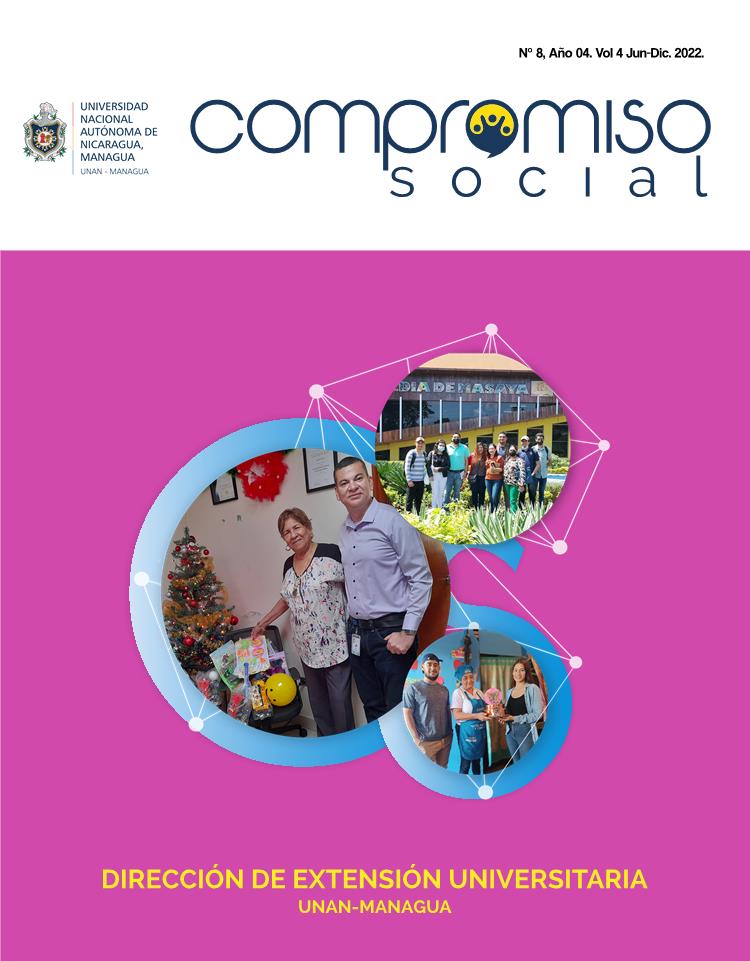Architectural Project Sendero Caballito San Juan de Oriente Towards A University Extension That Transcends
DOI:
https://doi.org/10.5377/recoso.v4i8.18631Keywords:
University Extension, Society, State, Architecture, IntegrationAbstract
This article applies the approach of information, personal experience, life stories, observations, historical texts, compilation of oral knowledge developing the extension architectural project of the National Autonomous University of Nicaragua UNAN-Managua, Faculty of Sciences and Engineering, Architecture career, in connection with the state and the university. In the architectural project Caballito San Juan de Oriente Path, concepts and models are identified, as well as specific experiences in the development of the extension function, the perspectives that are glimpsed towards its strengthening, the validity of the topic and its importance with the needs of the environment, offering solutions to the problems of the population in a two-way interaction that enriches the university and society in general. Regarding the actors of the University Extension, students of the 5th year of the architecture career, responsible teacher Dra. Arch. Marythel Garache, mayor's office of San Juan de Oriente, participated, each from their fields, aspects or substantive dimensions in environments of an inclusive paradigm. The University, among other functions, is called by society to establish itself as a faithful repository of knowledge and experience accumulated by humanity, involving complex activities that include various techniques, means, procedures, and objectives.
Downloads
References
Architecthum.edu.mx. (1999) Arquitectura y Humanidades. Recuperado de: http://www.architecthum.edu.mx/Architecthumtemp/glosario/PT.htm
ArchDaily. (2018). Arquitectura educacional, Universidad Macul, Chile. Recuperado de: https://bit.ly/2XRNC9e
Trujillo, L. (2017). Teorías pedagógicas contemporáneas. Recuperado de: https://digitk.areandina.edu.co/bitstream/handle/areandina/825/Teoríaspedagógicascontemporáneas.pdf?sequence=1&isAllowed=y
Hernández-Ascanio, José y Tirado-Valencia, Pilar y Ariza-Montes, Antonio (2016). El concepto de innovación social: ámbitos, definiciones y alcances teóricos. CIRIEC-España, Revista de Economía Pública, Social y Cooperativa, (88), 164-199. [Fecha de Consulta 27 de Noviembre de 2020]. ISSN: 0213-8093. Disponible en: https://www.redalyc.org/articulo.oa?id=174/17449696006
FRIGERIO, G.; DIKER, G. Educar: (sobre) impresiones estéticas. Buenos Aires: del estante editorial, 2008.• MORIN, E. Epistemología de la Complejidad. In: SCHNITMAN, D. (Org.). Nuevos Paradigmas, Cultura y Subjetividad. Buenos Aires: Paidós, 2004.
PINEAU, P. ¿Por qué triunfó la escuela? o la modernidad dijo: “Esto es educación” y la escuela respondió: “Yo me ocupo” In: PINEAU, P; DUSSEL, I.; CARUSO, M. La
Escuela como Maquina de Educar. Buenos Aires: Paidós, 2001.
PINEAU, P.; DUSSEL, I.; CARUSO, M. La Escuela como Maquina de Educar. Buenos Aires: Paidós, 2001.
Hunsen y Postlehwaite (1989) Enciclopedia internacional de la educación.
Freire, P. (2005). Pedagogía del Oprimido. Buenos Aires. Siglo XXI.
Hunsen, T. & Postlethwaite, N. (1989). Enciclopedia internacional de la educación. México: Ministerio de Educación y Ciencia.
Kahn, L. (1998). Conversaciones con estudiante. Barcelona: Editorial Gustavo Gil.
Lahoz Abab, P. 1992. Monográfico. El higienismo en la configuración del espacio escuela. Revista de educación, núm. 298. Pgs.89-118.
Lahoz Abab, P. 1991. El modelo froebeliano de espacio escuela. Su introducción en España. Universidad Española de educación a distancia. La educación en la España del siglo XX. Pgs.107-133.
Pozo Bernal M. Arquitectura y Pedagogía. La disolución del aula. Mapa de espacios arquitectónicos para un territorio pedagógico Barcelona 2014
Rosseau. Emilio, o de la educación. México: Porrua, 1999.
Ugarte, D. (2007). El poder de las redes. Manual ilustrado para personas, colectivos y empresas abocados al ciberactivismo. Madrid.
Downloads
Published
Issue
Section
License
Copyright (c) 2022 Universidad Nacional Autónoma de Nicaragua, Managua(UNAN-Managua)

This work is licensed under a Creative Commons Attribution-NonCommercial-ShareAlike 4.0 International License.




